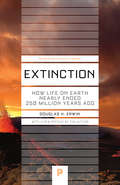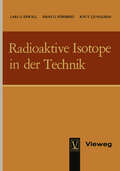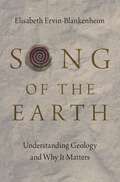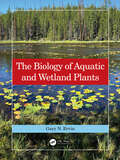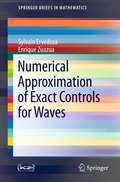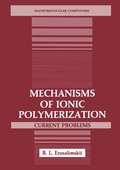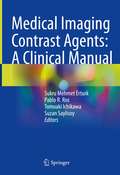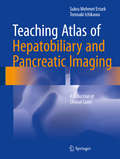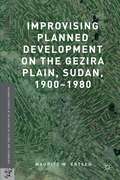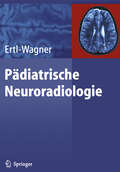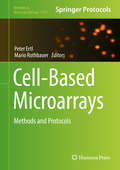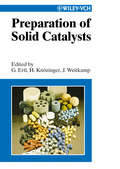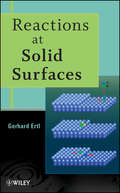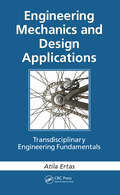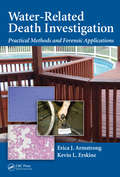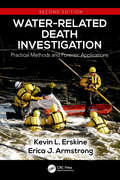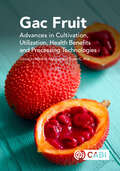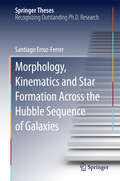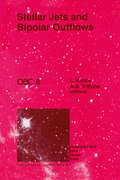- Table View
- List View
Extinction: How Life on Earth Nearly Ended 250 Million Years Ago
by Douglas H. ErwinSome 250 million years ago, the earth suffered the greatest biological crisis in its history. Around 95 percent of all living species died out—a global catastrophe far greater than the dinosaurs' demise 185 million years later. How this happened remains a mystery. But there are many competing theories. Some blame huge volcanic eruptions that covered an area as large as the continental United States; others argue for sudden changes in ocean levels and chemistry, including burps of methane gas; and still others cite the impact of an extraterrestrial object, similar to what caused the dinosaurs' extinction.Extinction is a paleontological mystery story. Here, the world's foremost authority on the subject provides a fascinating overview of the evidence for and against a whole host of hypotheses concerning this cataclysmic event that unfolded at the end of the Permian.After setting the scene, Erwin introduces the suite of possible perpetrators and the types of evidence paleontologists seek. He then unveils the actual evidence--moving from China, where much of the best evidence is found; to a look at extinction in the oceans; to the extraordinary fossil animals of the Karoo Desert of South Africa. Erwin reviews the evidence for each of the hypotheses before presenting his own view of what happened.Although full recovery took tens of millions of years, this most massive of mass extinctions was a powerful creative force, setting the stage for the development of the world as we know it today.In a new preface, Douglas Erwin assesses developments in the field since the book's initial publication.
Radioaktive Isotope in der Technik
by Lars Erwalldene Bücher über die technische Anwendung von Isotopen, doch ist keines so instruktiv und gut gegliedert wie die vorliegende Arbeit. Die Verfasser dieses Buches haben besondere Befähigungen für ihre Aufgabe. Die Arbeits gruppe für technische Anwendungen der Radio aktivität der Königlichen Technischen Hoch schule lieferte unter Leitung von Professor Torbjörn Westermark viele wesentliche Bei träge zur Isotopentechnik. später wurde diese Gruppe zu einer industriellen Forschungs-und Serviceorganisation, dem "Isotoptekniska La boratoriet", umgeformt. Für alle, die auf diesem großen Gebiet arbei ten oder sich für dieses interessieren, wird das vorliegende Buch von großem Nutzen und Gewinn sein. George Hevesy Vorwort der Verfasser Die skandinavische Industrie benutzt Radio-Isotope für viele Zwecke in Forschung und Produktion. Eine Anzahl von Organisationen: das dänische Isotopenzentrum, EKONO in Finnland, das Norwegische In stitut für Atomenergie und das Isotopen-Technik-Labor in Schweden haben sich zur Aufgabe gemacht, die Anwendung von Isotopen zu för dern und neue Bereiche zum Nutzen der Industrie zu entwickeln. Die se Organisationen haben erfolgreich und aktiv über einen längeren Zeitraum zusammengearbeitet. Eine Möglichkeit, die Benutzung radioaktiver Methoden zu fördern, besteht in der Verbreitung von Informationen und in der Ausbildung von industriellem Personal im Umgang mit diesen Methoden. Im Herbst 1961 wurden Ausbildungskurse in "Industrieller Isotopen-Technik" vom Isotopen-Technik-Labor veranstaltet. Die Nachfrage nach einem Lehrbuch in einer skandinavischen Sprache bestand seit langem; deshalb beschlossen wir, die während dieser Kur se gehaltenen Vorlesungen zu veröffentlichen. Diese Veröffentlichung erschien Ende 1962.
Song of the Earth: Understanding Geology and Why It Matters
by Elisabeth Ervin-BlankenheimA loving portrayal of our precious planet that offers easy-to-grasp discussions of scientific concepts and detailed examinations of Earth's tectonic, biological, and paleontological forces... Did you know that the history of Earth can be revealed by examining everything on it? From the esoteric science of minerals to the interactions between humans and their environment, our planet provides answers to every question we could ask about its history and what lies ahead. As climate change impacts everything we do on our planet, now is the time to take a closer look at what messages Earth has for us: what does it mean when the wind blows or the ground shifts? In this book, geologist Elisabeth Ervin-Blankenheim reveals the history of our planet through a geologic lens and explains why everyone should care about it. Song of the Earth is a thrilling biography of our planet that equips readers with the scientific, historical, and philosophical symbiosis between humans and Earth. Ervin-Blankenheim explores geologic principles of deep time, plate tectonics, and change in life forms in plain English. The book is illustrated with striking maps, diagrams, and pictures, allowing her to dissect everything from how a roiling, molten planet cooled to how the first cyanobacteria began to oxygenate the atmosphere to how the atmosphere has changed over time. Ervin-Blankenheim journeys through the science with ease and provides narrative sections about pioneering geologists and their groundbreaking discoveries. In viewing the planet as the integrated ecosystem it is, Ervin-Blankenheim showcases how land, water, life, and the atmosphere maintain an elegant yet delicate balance--one that, based on the author's evidence of current trends in the context of past planetary cataclysm, appears to be under imminent threat. At times both gripping and lovingly poetic, Song of the Earth shows not only how Earth has influenced life, but also how life has distinctly shaped our planet.
Song of the Earth: Understanding Geology and Why It Matters
by Elisabeth Ervin-BlankenheimA loving portrayal of our precious planet that offers easy-to-grasp discussions of scientific concepts and detailed examinations of Earth's tectonic, biological, and paleontological forces... Did you know that the history of Earth can be revealed by examining everything on it? From the esoteric science of minerals to the interactions between humans and their environment, our planet provides answers to every question we could ask about its history and what lies ahead. As climate change impacts everything we do on our planet, now is the time to take a closer look at what messages Earth has for us: what does it mean when the wind blows or the ground shifts? In this book, geologist Elisabeth Ervin-Blankenheim reveals the history of our planet through a geologic lens and explains why everyone should care about it. Song of the Earth is a thrilling biography of our planet that equips readers with the scientific, historical, and philosophical symbiosis between humans and Earth. Ervin-Blankenheim explores geologic principles of deep time, plate tectonics, and change in life forms in plain English. The book is illustrated with striking maps, diagrams, and pictures, allowing her to dissect everything from how a roiling, molten planet cooled to how the first cyanobacteria began to oxygenate the atmosphere to how the atmosphere has changed over time. Ervin-Blankenheim journeys through the science with ease and provides narrative sections about pioneering geologists and their groundbreaking discoveries. In viewing the planet as the integrated ecosystem it is, Ervin-Blankenheim showcases how land, water, life, and the atmosphere maintain an elegant yet delicate balance--one that, based on the author's evidence of current trends in the context of past planetary cataclysm, appears to be under imminent threat. At times both gripping and lovingly poetic, Song of the Earth shows not only how Earth has influenced life, but also how life has distinctly shaped our planet.
The Biology of Aquatic and Wetland Plants
by Gary N. ErvinAquatic plants play a critically important role in maintaining ecosystem health. They are natural biological filters in freshwater and estuarine wetlands; they contribute to the reproductive success of many organisms, some of which are harvested for food; they assist in flood control; and they are prominent elements in the aesthetics and recreational use of freshwater and estuarine habitats. Despite this globally recognized importance, wetlands have faced and continue to face threats from the encroachment of human activities. The Biology of Aquatic and Wetland Plants is a thorough and up-to-date textbook devoted to these plants and their interactions with the environment. The focus is on botanical diversity from the perspective of evolutionary relationships, emphasizing the role of evolution in shaping adaptations to the aquatic environment. By incorporating recent findings on the phylogeny of green plants, with special emphasis on the angiosperms, the text is broadly useful for courses in plant biology, physiology, and ecology. Additionally, a chapter on population biology and evolutionary ecology complements the evolutionary backdrop of hydrophyte biology by examining the details of speciation and applications of modern genetic approaches to aquatic plant conservation. Key Features • Synthesizes recent and seminal literature on aquatic and wetland plants • Emphasizes evolutionary history as a factor influencing adaptations to the wetland environment • Provides a global perspective on plant diversity and threats facing wetland ecosystems • Highlights research needs in the field of aquatic and wetland plant biology • Includes 280 figures, with more than 300 color photographs, and 41 tables to provide ease of access to important concepts and information
The Biology of Aquatic and Wetland Plants
by Gary N. ErvinAquatic plants play a critically important role in maintaining ecosystem health. They are natural biological filters in freshwater and estuarine wetlands; they contribute to the reproductive success of many organisms, some of which are harvested for food; they assist in flood control; and they are prominent elements in the aesthetics and recreational use of freshwater and estuarine habitats. Despite this globally recognized importance, wetlands have faced and continue to face threats from the encroachment of human activities. The Biology of Aquatic and Wetland Plants is a thorough and up-to-date textbook devoted to these plants and their interactions with the environment. The focus is on botanical diversity from the perspective of evolutionary relationships, emphasizing the role of evolution in shaping adaptations to the aquatic environment. By incorporating recent findings on the phylogeny of green plants, with special emphasis on the angiosperms, the text is broadly useful for courses in plant biology, physiology, and ecology. Additionally, a chapter on population biology and evolutionary ecology complements the evolutionary backdrop of hydrophyte biology by examining the details of speciation and applications of modern genetic approaches to aquatic plant conservation. Key Features • Synthesizes recent and seminal literature on aquatic and wetland plants • Emphasizes evolutionary history as a factor influencing adaptations to the wetland environment • Provides a global perspective on plant diversity and threats facing wetland ecosystems • Highlights research needs in the field of aquatic and wetland plant biology • Includes 280 figures, with more than 300 color photographs, and 41 tables to provide ease of access to important concepts and information
Numerical Approximation of Exact Controls for Waves (SpringerBriefs in Mathematics)
by Sylvain Ervedoza Enrique ZuazuaThis book is devoted to fully developing and comparing the two main approaches to the numerical approximation of controls for wave propagation phenomena: the continuous and the discrete. This is accomplished in the abstract functional setting of conservative semigroups.The main results of the work unify, to a large extent, these two approaches, which yield similaralgorithms and convergence rates. The discrete approach, however, gives not only efficient numerical approximations of the continuous controls, but also ensures some partial controllability properties of the finite-dimensional approximated dynamics. Moreover, it has the advantage of leading to iterative approximation processes that converge without a limiting threshold in the number of iterations. Such a threshold, which is hard to compute and estimate in practice, is a drawback of the methods emanating from the continuous approach. To complement this theory, the book provides convergence results for the discrete wave equation when discretized using finite differences and proves the convergence of the discrete wave equation with non-homogeneous Dirichlet conditions. The first book to explore these topics in depth, "On the Numerical Approximations of Controls for Waves" has rich applications to data assimilation problems and will be of interest to researchers who deal with wave approximations.
Mechanisms of Ionic Polymerization: Current Problems (Macromolecular Compounds)
by B.L. ErusalimskiiIn the last twenty years the literature on the processes of ionic polymerization has reached such a level that there is not a single question which is not covered by the information contained in the many monographs, reference books, and textbooks in this field. It is easy for the interested reader to find sources for in-depth study, for a superficial acquaintance with the fundamentals of the subject or with the general features of these processes. At the same time the field is being continually enriched by new facts which have not only broadened the data base but which influence existing concepts on the mechanisms of these reactions. Such influences often touch the very foundations of these concepts, i. e. , they go beyond simple descriptions of the structure of the pre-reaction states or earlier schemes. It is therefore appropriate to attempt a critical appraisal of the modern views on the mechanisms of formation of macro molecules in ionic systems which envisages, so far as is possible, the differentiating of fundamental and hypothetical conclusions or concepts. With this in mind we have preferred to address ourselves to the reader who is already quite well acquainted with the general litera ture. This has allowed us to dispense with detailed introductions to the questions discussed and to limit ourselves to brief comments on the fundamentals of the subject.
Medical Imaging Contrast Agents: A Clinical Manual
by Sukru Mehmet Erturk Pablo R. Ros Tomoaki Ichikawa Suzan SaylisoyThis volume highlights and broadens our understanding of the correct use and the possible contraindications of contrast agents applied in radiology. Written by experts in the field, it not only focuses on the chemistry, physiochemical properties and pharmacokinetics of both iodinated and gadolinium-containing contrast agents, but also on the relevant safety issues such as frequency of their short- and long-term side effects and ways to avoid them nephrotoxicity risk related to the iodinated contrast agents NSF (nephrogenic systemic fibrosis) accumulation of gadolinium in the brain use of contrast agents in pediatric patients and pregnancy It also includes essential data on the use of contrast agents, such as scanning protocols, in the context of various clinical conditions. This comprehensive manual addresses all professionals involved in radiological imaging and is an invaluable tool for radiologists and technologists, as well as for residents and clinicians.
Teaching Atlas of Hepatobiliary and Pancreatic Imaging: A Collection of Clinical Cases
by Sukru Mehmet Erturk Tomoaki IchikawaFeaturing 137 carefully selected cases, this atlas covers virtually every aspect of clinical cross-sectional imaging of the liver, gallbladder, biliary system and pancreas. For the vast majority of the cases, both CT and MR images are included to demonstrate the different features of each lesion. Furthermore, both typical and atypical pathologies are included to facilitate the differential diagnosis in daily clinical practice. Concise yet comprehensive,this atlas includes not only imaging features of the lesions but also the related pathologic and clinical data. It is therefore useful both as a quick guide for practicing radiologists and as a brief textbook for radiologists in training.
Improvising Planned Development on the Gezira Plain, Sudan, 1900-1980 (Palgrave Studies in the History of Science and Technology)
by Maurits W. ErtsenThe typical image of the Gezira Scheme, the large-scale irrigation scheme started under British colonial rule in Sudan, is of a centrally planned effort by a central colonial power controlling tenants and cotton production. However, any idea(l)s of planned irrigation and profit in Gezira had to be realized by African farmers and European officials, who both had their own agendas. Projects like Gezira are best understood in terms of continuous negotiations. This book rewrites Gezira’s history in terms of colonial control, farmers’ actions and resistance, and the broader development debate.
Pädiatrische Neuroradiologie
by Birgit Ertl-WagnerOhne komplizierte Technikdetails, didaktisch klar und mit vielen Lernhilfen bietet Ihnen der Leitfaden praxisbezogene Entscheidungshilfen für eine präzise Diagnostik. Ein Werk, mit dem Einsteiger leicht lernen und Erfahrene schnell diagnostische Fragestellungen klären.
Cell-Based Microarrays: Methods and Protocols (Methods in Molecular Biology #1771)
by Peter Ertl Mario RothbauerThis volume provides a comprehensive look at the current fabrication methods, materials, cell patterning techniques, and practical application of live-cell microarrays. The chapters in this book are categorized into six parts: introduction, biointerface engineering and live-cell microarrays, printing techniques for live-cell microarrays, live-cell microarray application, microfluidic live-cell arrays, and advanced materials suitable for live-cell microarrays. Some of the topics covered are artificial micro-niche array with spatially structured biochemical cues; inkjet printing for biomedical application; fabrication of multi-electrode arrays for neurobiology applications; rapid prototyping of thermoplastic microfluidic devices; and oxygen-generating photocrosslinkable hydrogel. Written in the highly successful Methods in Molecular Biology series format, chapters include introductions to their respective topics, lists of the necessary materials and reagents, step-by-step, readily reproducible laboratory protocols, and tips on troubleshooting and avoiding known pitfalls. Cutting-edge and thorough, Cell-Based Microarrays: Methods and Protocols is a valuable resource for anyone interested in expanding their knowledge and research of cell-based microarrays.
Preparation of Solid Catalysts
by Gerhard Ertl Jens Weitkamp Helmut KnözingerSolid catalysts play a fundamental role in all areas between basic research and industrial applications. This book offers a large amount of information about the preparation of solid catalysts. All types of solid catalysts and all important aspects of their preparation are discussed. The highly topical contributions are written by leading experts in disciplines ranging from solid state, interface and solution chemistry to industrial engineering. The straightforward presentation of the material and the comprehensive coverage make this book an essential and indispensible tool for every scientist and engineer working with solid catalysts.
Reactions at Solid Surfaces (Baker Lecture Series #14)
by Gerhard ErtlExpanding on the ideas first presented in Gerhard Ertl's acclaimed Baker Lectures at Cornell University, Reactions at Solid Surfaces comprises an authoritative, self-contained, book-length introduction to surface reactions for both professional chemists and students alike. Outlining our present understanding of the fundamental processes underlying reactions at solid surfaces, the book provides the reader with a complete view of how chemistry works at surfaces, and how to understand and probe the dynamics of surface reactions. Comparing traditional surface probes with more modern ones, and bringing together various disciplines in a cohesive manner, Gerhard Ertl's Reactions at Solid Surfaces serves well as a primary text for graduate students in introductory surface science or chemistry, as well as a self-teaching resource for professionals in surface science, chemical engineering, or nanoscience.
Engineering Mechanics and Design Applications: Transdisciplinary Engineering Fundamentals
by Atila ErtasIn the last decade, the number of complex problems facing engineers has increased, and the technical knowledge required to address and mitigate them continues to evolve rapidly. These problems include not only the design of engineering systems with numerous components and subsystems, but also the design, redesign, and interaction of social, politic
Modern Electrical Drives (NATO Science Series E: #369)
by H. Bülent Ertan M. Yildirim Üçtug Ron Colyer Alfio ConsoliElectrical drives lie at the heart of most industrial processes and make a major contribution to the comfort and high quality products we all take for granted. They provide the controller power needed at all levels, from megawatts in cement production to milliwatts in wrist watches. Other examples are legion, from the domestic kitchen to public utilities. The modern electrical drive is a complex item, comprising a controller, a static converter and an electrical motor. Some can be programmed by the user. Some can communicate with other drives. Semiconductor switches have improved, intelligent power modules have been introduced, all of which means that control techniques can be used now that were unimaginable a decade ago. Nor has the motor side stood still: high-energy permanent magnets, semiconductor switched reluctance motors, silicon micromotor technology, and soft magnetic materials produced by powder technology are all revolutionising the industry. But the electric drive is an enabling technology, so the revolution is rippling throughout the whole of industry.
Water-Related Death Investigation: Practical Methods and Forensic Applications
by Kevin L. Erskine Erica J. ArmstrongAll too often, police called to the scene of a water-related death may consider it an accidental drowning before they even arrive. But the investigation of these types of deaths requires the same careful and thorough documentation as in other potentially non-natural deaths and these efforts must be carried through all stages of investigation. Water
Water-Related Death Investigation: Practical Methods and Forensic Applications
by Kevin L. Erskine Erica J. ArmstrongNearly ten years after the first edition of Water-Related Death Investigation: Practical Methods and Forensic Applications, water death cases continue to be improperly investigated. The pathologist’s report can determine the cause of death as a drowning, but the manner of death is the most challenging to prove. The report will not determine if a victim jumped into the water to commit suicide, fell into the water accidentally, or was pushed in as a homicidal act. Many drowning cases do not reflect injury to the body, so evidence collected at the scene plays a vital role. The importance of an on-scene body assessment cannot be overemphasized. Often, the body evidence begins to change rapidly upon recovery and may not be present during an autopsy. Written statements on the scene are an effective tool to use to determine the accuracy of information given to arriving officers. These statements need to be written by the witnesses themselves as well as the reporting person. The "Show Me" technique can also help reveal discrepancies in a person’s version of what occurred as well as aid in providing the most details to an incident as is humanly possible. This second edition includes updated information on the latest technology to assist water death investigators. Parabon Snapshot can help determine the faceless identity of skeletal remains and help locate potential suspects using the science of DNA. Drones can aid in locating missing persons as well as human remains, even months after death. Updated information is provided regarding fingerprints from submerged objects, and Carbon-14 can help determine the origin of a found corpse. Key Features: Thoroughly reviews the physiological aspects of drowning Reveals the investigative characteristics inherent to various scenes of water-related deaths Highlights certain "red flag" indicators that may point to foul play or scene staging Outlines autopsy protocols, trial preparation, and expert witness testimony Provides numerous case studies and numerous illustrations to further clarify key points presented in the text Coauthored by a Master Water Death Investigator and an experienced forensic pathologist, Water-Related Death Investigation: Practical Methods and Forensic Applications, Second Edition merges the essentials of evidence collection and field investigation with autopsy best practices and laboratory testing. It will continue to serve as a valuable resource for the various professionals involved in these cases.
Water-Related Death Investigation: Practical Methods and Forensic Applications
by Kevin L. Erskine Erica J. ArmstrongNearly ten years after the first edition of Water-Related Death Investigation: Practical Methods and Forensic Applications, water death cases continue to be improperly investigated. The pathologist’s report can determine the cause of death as a drowning, but the manner of death is the most challenging to prove. The report will not determine if a victim jumped into the water to commit suicide, fell into the water accidentally, or was pushed in as a homicidal act. Many drowning cases do not reflect injury to the body, so evidence collected at the scene plays a vital role. The importance of an on-scene body assessment cannot be overemphasized. Often, the body evidence begins to change rapidly upon recovery and may not be present during an autopsy. Written statements on the scene are an effective tool to use to determine the accuracy of information given to arriving officers. These statements need to be written by the witnesses themselves as well as the reporting person. The "Show Me" technique can also help reveal discrepancies in a person’s version of what occurred as well as aid in providing the most details to an incident as is humanly possible. This second edition includes updated information on the latest technology to assist water death investigators. Parabon Snapshot can help determine the faceless identity of skeletal remains and help locate potential suspects using the science of DNA. Drones can aid in locating missing persons as well as human remains, even months after death. Updated information is provided regarding fingerprints from submerged objects, and Carbon-14 can help determine the origin of a found corpse. Key Features: Thoroughly reviews the physiological aspects of drowning Reveals the investigative characteristics inherent to various scenes of water-related deaths Highlights certain "red flag" indicators that may point to foul play or scene staging Outlines autopsy protocols, trial preparation, and expert witness testimony Provides numerous case studies and numerous illustrations to further clarify key points presented in the text Coauthored by a Master Water Death Investigator and an experienced forensic pathologist, Water-Related Death Investigation: Practical Methods and Forensic Applications, Second Edition merges the essentials of evidence collection and field investigation with autopsy best practices and laboratory testing. It will continue to serve as a valuable resource for the various professionals involved in these cases.
Eine kontaktlose Alternative für das respiratorische Gating in der PET: Entwicklung eines Doppler-Radarsensors für die Positronen-Emissions-Tomographie (Forschungsreihe der FH Münster)
by Thomas ErsepkeThomas Ersepke entwickelt einen kontaktlosen Radarsensor, der eine vielversprechende Alternative für die Respirationsmessung in der Positronen-Emissions-Tomographie (PET) darstellt. In der PET führen längere Aufnahmezeiten in Kombination mit der Atmung des Patienten zu einer Bewegungsunschärfe in den rekonstruierten Bilddaten. Das respiratorische Gating ist eine Methode zur Kompensation dieser Artefakte und benötigt ein Respirationssignal des Patienten. Klinisch etablierte Methoden zur Respirationsmessung in der PET erfordern eine Sensorik am Patienten, deren Anbringung zeitaufwändig ist. Das Continuous-Wave-Doppler-Radar-Verfahren ist eine Methode zur kontaktlosen Bewegungsdetektion und basiert auf der Messung der Phasenverschiebung eines an einem bewegten Ziel reflektierten Signals. Während der Validierung des Sensors und dem Vergleich mit klinisch etablierten Messverfahren kann der Autor hohe Messgenauigkeiten sowie hohe Korrelationen zu den Standardverfahren nachweisen.
Gac Fruit: Advances in Cultivation, Utilization, Health Benefits and Processing Technologies
by Servan Ersan Chuyen V. Hoang Tien Huynh Van Anh Le Cang H. Mai Judith Müller-Maatsch Dao T. Nguyen Sophie E. Parks Huan Phan-Tai Huu Tai Pham Ngoc T.M Ta Xuan T. TranGac fruit, Momordica cochinchinensis Spreng, is rich in nutrients such as carotenoids (particularly ß-carotene and lycopene), fatty acids, vitamin E, polyphenol compounds and flavonoids. This book provides the latest research on this fruit, from cultivation through to novel processing technologies for health products. It addresses several techniques for propagation and cultivation in order to increase the production and quality of Gac fruit, including traditionally used parts of the fruit (aril) and those whose value has not yet been maximized (peel, pulp and seed). This plant has the potential to be a high value crop, particularly as parts of the fruit can be processed into nutrient supplements and natural colorants. Currently only the aril is commercially harvested, and this presents opportunities for upcycling the rest of the fruit. As such, this book contains special emphasis on: · Improving yield and fruit quality. · Extraction methods of Gac oil rich in ß-carotene and lycopene from the aril and peel. · Encapsulation of Gac oil and applications in various food products. · Nutritional values and bioactive compounds of Gac pulp and peel. · Processing and utilization of Gac seeds. · The market for Gac target products. Practical applied technologies such as microwave drying, heat pump drying, freeze drying, ultrasound assisted extraction, supercritical CO2 extraction, encapsulation techniques are all presented. This is an essential reference text for academics, researchers and graduate students in Gac fruit cultivation, food processing, science and nutrition. Product developers in health food and health supplements will also find it valuable.
Morphology, Kinematics and Star Formation Across the Hubble Sequence of Galaxies (Springer Theses)
by Santiago Erroz-FerrerThis thesis discusses the evolution of galaxies through the study of the morphology, kinematics, and star formation properties of a sample of nearby galaxies. The main body of the thesis describes the kinematic observations with the GHaFAS Fabry-Perot instrument on the William Herschel Telescope of a sample of 29 spiral galaxies. The work is closely related to the Spitzer Survey of Stellar Structure in Galaxies, and uses the mid-infrared data of that survey to determine key parameters of the galaxies studied. From these data, important results are obtained on streaming and other non-circular motions in galaxies, on the distribution and rates of star formation, and on how correlations of these parameters and of the rotation curve shape with basic galaxy parameters yield clues on the evolutionary processes taking place in disk galaxies.
Stellar Jets and Bipolar Outflows: Proceedings of the Sixth International Workshop of the Astronomical Observatory of Capodimonte (OAC 6), Held at Capri, Italy, September 18–21, 1991 (Astrophysics and Space Science Library #186)
by L. Errico Alberto A. VittoneIn the last few years great improvements in the study of stellar jets and bipolar outflows have been achieved, both observationally and theoretically. High resolution observations at various frequencies (radio, IR, optical and X-ray) of these features in different types of objects have shown a large variety of morphologies at all scales often revealing contrasting symmetries which do not allow straightforward kinematic interpretations valid for all cases. In particular, at present, it seems very difficult to give a statistical definition of what the "standard properties" of jets and bipolar outflows are. On the theoretical side, the identification of physical processes capable of producing the observed rich morphological variety of jets and bipolar outflows and supporting them over long lifetimes is still controversial. Furthermore several models are actively discussed in an attempt of reaching a complete understanding of the phenomenon. The workshop provided an unique opportunity for both observers and theoreticians to gather together and produce an updated and exhaustive picture of the field. In addition the meeting has been enriched by the presentation of some works on jets in external galaxies. This topic was focused on what people working on stellar jets could learn from colleagues working on extragalactic jets and vice versa. Invited papers were prepared with the aim of giving the state of the art about scientific subjects; contributed papers and some selected poster papers presented, on the contrary, very recent results in the various fields.
Einsamkeit und die psychologische Kraft der Marke
by Oliver ErrichielloIn eingängiger, prägnanter und oftmals humorvoller Weise beleuchtet dieses Buch die übergreifenden psychologischen Kräfte des „Kultursystems Marke“. Es lässt von Sigmund Freud über Erich Fromm bis hin zu Dagobert Duck klassische sozialpsychologische Denker, Wissenschaftler und Alltags-Philosophen zu Wort kommen. Die Marke taucht in allen Kulturen, Wirtschaftssystemen und über alle Zeitalter hinweg auf – sie ist der Dinosaurier der Ökonomie. Alles nur Manipulation? Die Lebenswirklichkeit beweist: Die Vorstellung eines rationalen „Verbrauchers“ ist falsch. Vielmehr wählen wir lustvoll aus den Möglichkeiten aus, die die Warenwelt uns bietet – egal ob Luxuslimousine oder Bio-Supermarkt. Die Entscheidung für eine Marke ist auch immer eine Aussage wie wir selbst gesehen werden wollen und vor allem welcher Gemeinschaft wir angehören: Lidl oder ALDI, BMW oder VW, Domestos oder Frosch. Indem wir uns für-oder-gegen bestimmte Waren und Dienstleistungen entscheiden, vergrößern wir unsere eigenen Möglichkeiten und schärfen unser Ich gegenüber der Außenwelt: Wir werden als Individuen erkennbar. Damit lindert die Marke eine fundamentale Angst des Menschen: Die Einsamkeit. Als Gefühl gefürchtet, wirkt sie ökonomisch als zutiefst schöpferische Kraft in Gestalt der Marke – und ist deshalb nicht zu überwinden. Dieses Buch hält spannende und überraschende Erkenntnisse für alle diejenigen bereit, die schon immer wissen wollten, warum Marken immer und überall zu finden sind.
